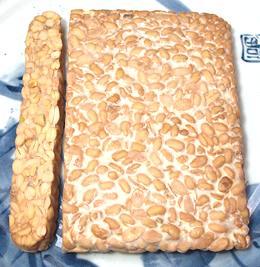 [Tempe (Java)]
[Tempe (Java)]
This traditional Indonesian product is made from soft cooked soybeans infected with a colony of Rhizopus oligosporus mold to make the most meat-like of fermented soy products. Does it taste like meat? No - it has its own flavor and texture, but it's close enough to the ballpark to stand in for chicken and pork where those are too costly. Of course here in North America tempeh costs more than chicken or pork, but is favored by strict vegetarians.
Back in the '70s when William Shurtleff and Akiko Aoyagi wrote The Book of Tempeh, tempeh was the "great white hope" of vegans - finally a vegetable source of vitamin B12. That hope evaporated when tempeh started being made to Western handling and processing standards. The vitamin B12 had come from bacterial and insect contamination, just as it had with Spiralina before it (T1). There simply is no natural vegetarian source sufficient to supply this absolutely essential vitamin.
In those idealistic times, the socially concious were reading Francis Moore Lappé's Diet for a Small Planet and expected vegetarianism to take over the world. Surtleff and Aoyagi anticipated tempeh shops springing up in every community. Well, there are probably some aging hippies up San Francisco way, or in Oregon, running tempeh shops, and we have at least one guy down here in Los Angeles making some as a side line. Of course, as primary port of entry for the Pacific Rim, we are well stocked with frozen tempeh from Asia. The photo specimen was 3/4 inch thick and about 5 inches by 5-1/2 inches weighing 11 ounces.
I bought (and read) The Book of Tempeh when it came out in 1979 (and still have my disintegrating copy), but even in my bead wearing vegetarian days I was not a very good hippie. I confess that I had not tasted tempeh until 2010 when I wanted to clear some photo samples out of my freezer compartment.
Tempeh is a nice change of texture for hard core vegetarians, but is not so satisfying for omnivours. Compared to chicken it is much firmer and the texture is pebbly rather than stringy. Flavor is nutty rather than savory and it's a bit dry rather than succulent. It is, however, reasonably palatable.
More on Products from Beans.
You may find fresh tempeh in natural food stores, and may be able to find a local producer. Here in Los Angeles Dave's Gourmet Korean sells it at a number of local certified farmers markets (yes, you have to go to one to get it, no Web site, no orders, no store (Aug 2009)).
Tempeh can also be grilled or broiled, or crumbled and cooked similar to ground meat. It is also sometimes boiled or steamed, and very fresh tempeh can be eaten raw.
Making Tempeh: Tempeh is not difficult to make, but does require building a primitive incubator so the temperature is tightly controlled. The main hassle is dehulling the soybeans. Dry process requires a very loosly adjusted grain grinder, wet process just needs pans. You can easily find instructions and sources for the mold culture on the Internet.
Tempeh is about 20% protein, which is of a fairly high quality in keeping with other soy products. It has about 50 calories per ounce and, unlike many fermented soy products, it is low in salt. It has good amounts of Calcium, Iron and Zinc.
Because tempeh is a thoroughly fermented product, it is low in the toxins and hormone-like substances some non-fermented soy products are suspected of, and is generally considered safe in any reasonable quantity. Because it includes the complete bean (less husk) it is more nutritious than tofu.